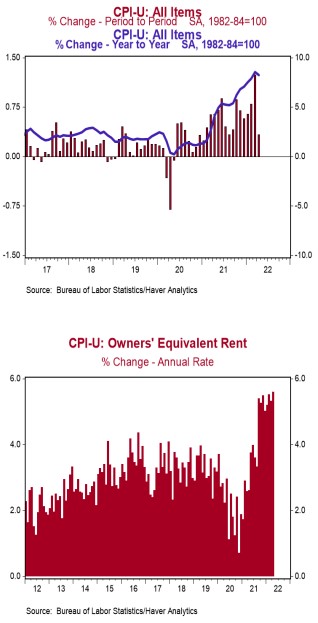- The Consumer Price Index (CPI) increased 0.3% in April, above the consensus expected +0.2%. The CPI is up 8.3% from a year ago.
- Food prices increased 0.9% in April, while energy prices declined 2.7%. The "core" CPI, which excludes food and energy, rose 0.6% in April, above the consensus expected +0.4%. Core prices are up 6.2% versus a year ago.
- Real average hourly earnings – the cash earnings of all workers, adjusted for inflation – declined 0.1% in April and are down 2.6% in the past year. Real average weekly earnings are down 3.4% in the past year.
Implications:
The inflation report for April shows that inflation is nowhere near "transitory" and is likely to be with us for multiple years to come. Consumer prices rose 0.3% in April, which was higher than the consensus expected +0.2%. But, more importantly, "core" prices, which exclude food and energy, rose 0.6% versus a consensus expected +0.4%. Although some analysts and investors might take solace in the fact that headline inflation ticked down on a year-ago comparison basis, to 8.3% in April from 8.5% in March, that doesn't mean inflation is going to drop anywhere as fast as the Federal Reserve hopes. Looking at the details of today's report, prices for shelter, food, and airline fares were the main drivers of April's increase. Historically, food and energy prices have been very volatile month to month. That was true once again in April, as food prices rose 0.9% and energy fell 2.7%. But "core" prices showed more substantial inflation pressure. Housing rents (for both actual tenants and the rental value of owner-occupied homes) continued to move higher in April, rising 0.5% for the month. We expect rents to be a key driver for inflation in 2022 and beyond because they make up more than 30% of the overall CPI and still have a long way to go to catch up to home prices, which have skyrocketed more than 30% since COVID started. Airline fares posted the largest monthly increase on record ( 18.6%) dating back to 1963, signaling increased demand from COVID re-opening. Meanwhile, the auto sector had a split picture for inflation for the month. New vehicle prices rose 1.1% in April and are up 13.2% from a year ago. Used cars and trucks, however, are starting to see a turn in prices; although they're up 22.7% from a year ago, they declined 0.4% in April for the third straight monthly decline. The M2 measure of the money supply soared during COVID and now consumers are paying the price in much higher inflation. Until the Fed gets growth in the money supply under persistent control, high inflation is here to stay.





